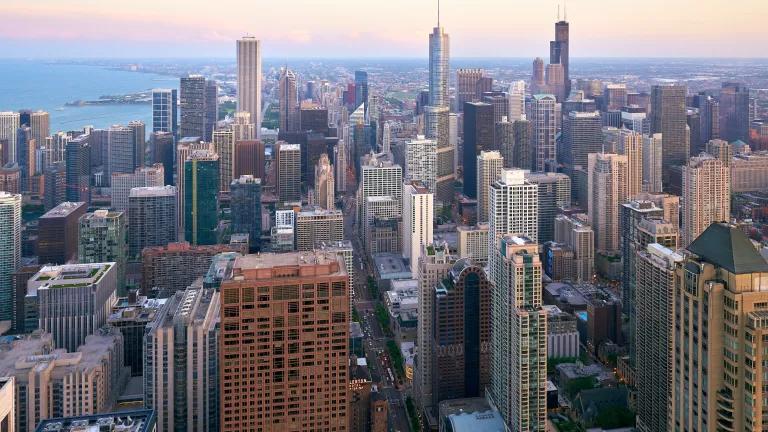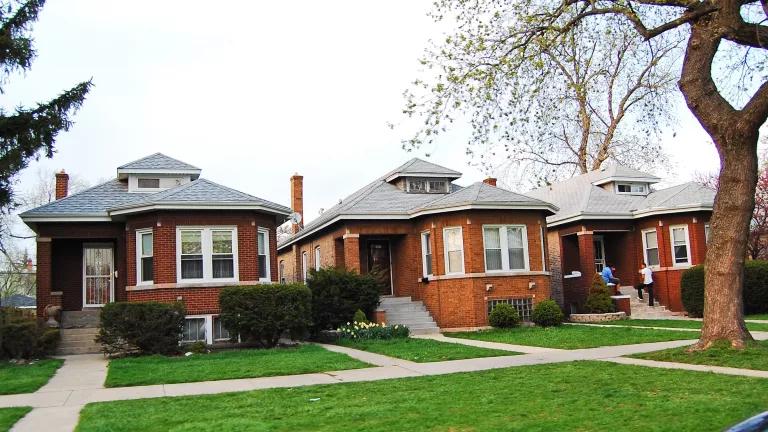Healthier Buildings as a Climate Solution for Chicago
Communities of color must have a seat at the table as we come up with standards to remove emissions from our buildings and ultimately make them healthier to live in.

Sunset on the South Side
Co-authored with Yessenia Balcazar, Southeast Environmental Task Force senior resilient community planning manager, and Courtney Hanson, People for Community Recovery deputy director
At a time when we’re seeing extreme heat, droughts, floods, and other weather disasters due to climate change, it’s never been more important to take action on climate locally. As the third-most populous city in the country, our buildings are responsible for the bulk of Chicago’s carbon pollution and the release of toxic air pollutants such as nitrous oxides and particulate matter that are harmful to human health, particularly for frontline communities that bear the brunt of the cumulative impacts of the city’s industrial and diesel truck pollution.
In residential and commercial buildings, these emissions are the result of burning fossil fuels such as gas and propane to power heating, cooking, and clothes-drying appliances. Addressing the public health and climate crisis in Chicago will involve addressing the emissions that come from our buildings.
Communities of color struggle to be seen and heard as we all continue to fight a global problem that hurts these communities the most. It’s critical that they have a seat at the table as standards are being developed to remove these emissions from our buildings and ultimately make them healthier to live in.
Above all, equity for low-income households and communities of color, who suffer disproportionately from the climate crisis, must be weaved into the policies that will direct the millions of local, state, and federal dollars dedicated to improving building standards.
Our communities want policies that will improve public health, promote new workforce and job opportunities, and reduce household energy burden.
Chicago buildings produce 69 percent of the city’s current emissions, and large buildings (more than 50,000 square feet) are responsible for approximately 20 percent of these emissions.
As part of Chicago’s 2022 Climate Action Plan, the city has committed to reducing emissions 62 percent by 2040, and as part of the National Building Performance Standards Coalition, the city has committed to proposing a Building Performance Standard (BPS) by Earth Day of 2024. A BPS is a powerful tool for reducing greenhouse gas emissions in existing buildings. As this standard is developed, communities that are most impacted must be at the decision-making table to lend their expertise.
A Chicago BPS will affect disinvested communities, making the requirements developed as part of the new policy an opportunity to address the existing inequitable costs of housing and energy.
As the city acts to reduce emissions in buildings, it must consider the following recommendations:
- Design a BPS to maximize benefits related to utility affordability and indoor air quality for communities with a high energy burden and high rates of respiratory illness; one that is also balanced with precautions that ensure costs are not passed on to residents of affordable housing. The BPS ordinance should set parameters regarding whether and to what degree building owners can pass improvement costs on to tenants and ensure Chicago’s current tenant protections are sufficient to prevent unfair displacement.
- Residents in underserved neighborhoods also have a lack of large building development in their communities, underscoring the importance of prioritizing smaller buildings through a BPS. In cities that are implementing or have passed a BPS, most are only including buildings with a minimum area of 50,000 square feet. However, some cities have recognized that communities like ours—with widespread energy burden and debt—do not have a single building that meets such a high threshold. Therefore, we recommend implementing a BPS in Chicago that joins New York City and Boston as national leaders by incorporating all buildings that are 25,000 square feet and larger.
- An equitable BPS must also include funding and technical support for affordable, multifamily buildings located in environmental justice and low- to moderate-income communities. In order to enact and regulate this, the city should assemble a Community Accountability Board, a common body comprised of community leaders and advocates with the authority to approve standards, help determine funding, and assist in implementation rules of the ordinance.
Finally, we know a BPS may not benefit all Chicago residents seeking climate-friendly home upgrades. Therefore, the BPS should establish a building decarbonization hub that provides technical assistance and funding support for climate-friendly home upgrades.
Environmental justice communities are already doing the challenging work of connecting residents with climate-friendly programs that have little to no support. Launching a robust resources hub that streamlines access to assistance and prioritizes resources to support community-led outreach would ensure that a BPS and its complementary programs are reaching Chicagoans with the greatest need.
Every day, Chicago residents are struggling to pay their gas bills and continue to be at risk for health effects in their homes due to unhealthy indoor air quality. We are counting on the city to take immediate action.




